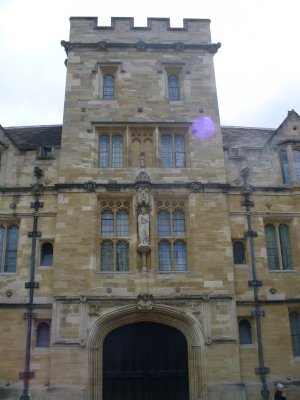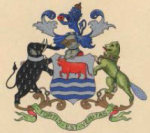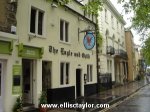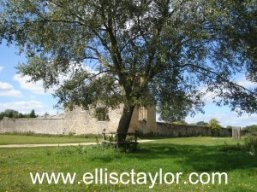This is Part 2 of Now you see it…Now you don’t.
This is a re-formatted article that was on my former website. It was part of a larger article on Oxford published in August 2008.
Here glow the lamps,
And teaspoons clatter to the cosy hum
Of scientific circles…
‘Q’
Osenfort
Authorities recently sanctioned the public release (through the Oxford Mail, on Isis Day, 17th July, 2008) of the astonishing news that a huge henge, measuring at least 150 metres diameter, had been discovered less than half a mile to the north of Carfax, at the centre of Oxford. The massive megalithic* site, far bigger than Stonehenge, had been realised, they claim, when builders were preparing land behind houses in St Giles for the new ‘Kendrew Quadrangle’ development by St John’s College.
*Not strictly ‘megalithic’, as far as anyone but the surely damned coveters know, until integral large stones have been reported.
Archaeologists determined that the circular henge was surrounded by a moat, 8 metres wide and 2.5 metres deep and that this ancient ‘fortified’ island encloses all of present-day Keble College as well as Pitt-Rivers Museum:
“More recently, a ditch discovered back in March has now been identified as being part of a very rare monument type called a ‘henge’, which was created in the late Neolithic and Bronze Age (c. 2300 BC) round the same time as Stonehenge. The ditch excavated here is up to 8m across and at least 2.5m deep, curves only very slightly and based on the small part of the plan so far recovered, would have enclosed an area of at least 150m diameter, encompassing all of what is now Keble College and the Pitt Rivers Museum.” Thames Valley Archaeological Services
 In quick-smart fashion the builders, upright and square, Kingerlee (clock the logo, would ya) were requested to fill it all in and get on with the job, which they are.
In quick-smart fashion the builders, upright and square, Kingerlee (clock the logo, would ya) were requested to fill it all in and get on with the job, which they are.
In March 2008, a heap of up to 40 bodies were unearthed during the groundwork phase. By law, even for an Oxford money-bags like St. Johns, work had to stop.
Thames Valley Archaeological Services were contracted by the college to carry out an archaeological survey of the site whereupon they discovered numerous artefacts belonging to eras reaching back into the Iron Age, the last found laying at the bottom of the moat. (1)
St. Johns College started out as St. Bernard’s College in 1437 and was named in honour of the Knight’s Templar patron, St. Bernard of Clairvaux, whose statue it is that stands above the entrance to the college today – according to Jan Morris, in her book, ‘Oxford’:
” …and the figure of St. Bernard on the gate-tower of St. John’s, whose buildings were formerly a
Cistercian House, was hastily fixed up with cement hair and a beard, and turned into John the
Baptist (until 1915 when he became St. Bernard again).” (2)
 (The Order of the Templars had been routed in France 130 years previous to this college’s foundation – note the number 13. Their fabulous wealth just disappeared.)
(The Order of the Templars had been routed in France 130 years previous to this college’s foundation – note the number 13. Their fabulous wealth just disappeared.)
The college was torched during the Dissolution before literally rising from the ashes with a name change and a dedication to the Templar/Hospitaller divine, ‘John the Baptist’ in 1555.
St. John’s College is extremely rich. It is said that a traveller could walk from St. John’s, Oxford to St. John’s, Cambridge without stepping off this institution’s wallet.
On St. John’s Day, 24th June, 1646, the Royalists surrendered to the Parliamentarians at Oxford. King Charles (answering to the alias ‘Harry’) had travelled east legged it escaped out the East Gate passed Magdalen College, and across the Cherwell – slipping through Marsh Baldon on the way.
Alumni include the Jesuit martyr Edmund Campion, inventor Jethro Tull, poets and writers A.E. Houseman, Robert Graves, Philip Larkin and Kingsley Amis, fugitive from justice, Tony Blair, and (nearly because he failed the entrance exam) the camel-riding hero T.E. Lawrence (Morse, however, did get through.)
The site where the Henge was uncovered is between numbers 20 to 22 St Giles, which is a little north of the actual college. It is on land where at one time ‘Black Hall’ stood.
www.headington.org.uk/oxon/stgiles/tour/east/20.htm
www.headington.org.uk/oxon/stgiles/tour/east/21.htm
www.headington.org.uk/oxon/stgiles/tour/east/22_23.htm
This surprise discovery has occurred in exactly the right location for these times – one long marked and inscribed to the herald of Christ, St. John the Baptist (a water-carrier), and ostensibly for a major new building dedicated to a person whose first name matches the college’s, and surname means ‘the son of man’ – (Kendrew)!
As well as this, the circle was discovered behind a house named after the Virgin Queen, Elisabeth I, who was the founder of the stag-badged Jesus College and the royal grantor of the city’s unique crest that caps its coat-of-arms – a leopard dotted with blue fleurs-de-lys sporting the royal crown and holding the Tudor Rose in its paws – but looking, I must point out, rather more like a 5-spoked red star-wheel than a rose…which is pretty damned interesting. The cat at the hat too (see above). (3)
 St. Johns College, which already owned the Lamb and Flag (St. John’s
St. Johns College, which already owned the Lamb and Flag (St. John’s  and Templar emblems) public house, has just acquired the Eagle and Child (Eagle is John the Baptist’s symbol) directly across from each other in St. Giles: which means to say that they came to own both of these Johannine-moniker-ed pubs, just in the nick of time. (4)
and Templar emblems) public house, has just acquired the Eagle and Child (Eagle is John the Baptist’s symbol) directly across from each other in St. Giles: which means to say that they came to own both of these Johannine-moniker-ed pubs, just in the nick of time. (4)
With the building of this quad, precisely where this revealed great circle is located, in full public view, St. John’s (the college of the Templars) are moving to square the circle!
As I have been relaying, Oxford is ‘the Womb of the World’ and the New Age, of Aquarius, the water-bearer, will be initiated here. Indeed it could be argued that the decidedly unpopular (amongst local citizens past and present) St. John’s is a water-bearer itself, being named after the Baptist.
Very close to the Oxford Henge long barrows, round barrows, and other ritual sites have been discovered, in what is  now known as the University Parks, and under Wycliffe Hall, in Summertown, under Ss. Philip and James Church in Woodstock Road and on Port Meadow. The site is only a stone’s throw (not one of those big ones. If it is I ‘ent chuckin’ it!) from the 12th Century, St. Giles Church, which might help to explain the dismay that social and religious historians have long expressed regarding the necessity of this large church so close to St. Mary Magdalen’s Church, which is also outside the old city boundary. Was St. Giles built on the henge site, or on top of something associated with it perhaps?
now known as the University Parks, and under Wycliffe Hall, in Summertown, under Ss. Philip and James Church in Woodstock Road and on Port Meadow. The site is only a stone’s throw (not one of those big ones. If it is I ‘ent chuckin’ it!) from the 12th Century, St. Giles Church, which might help to explain the dismay that social and religious historians have long expressed regarding the necessity of this large church so close to St. Mary Magdalen’s Church, which is also outside the old city boundary. Was St. Giles built on the henge site, or on top of something associated with it perhaps?
Oxford, and its environs, has been like a candle to moths in regard to religious orders of every creed, clandestine or otherwise. The colleges were mainly founded by, or under the influence of, clerics – they still are in many ways.
Away to the west, on a wicket-straight alignment – Ley Line – that bowls its way through ‘the Oxford Henge’ is the hauntingly beautiful, yet austere little church of St. Margaret of Antioch in Binsey.
The APL of Elsie’s eye,
A Queen’s kin by and by.
To Binsey…by boat
In line and by rote
‘E’
 The church building, these days, is a long way from the village it serves but once-upon-a-time, the whole village, like its neighbours Osney and Hinksey, was entirely isolated. Like them it was built on an island in those then untamed and misty wetlands of Oxford’s original marshes and meres.
The church building, these days, is a long way from the village it serves but once-upon-a-time, the whole village, like its neighbours Osney and Hinksey, was entirely isolated. Like them it was built on an island in those then untamed and misty wetlands of Oxford’s original marshes and meres.
It was to here, so the legend goes, that Frideswide fled and it was in this little place, supposedly in the oak forests – which is unlikely – that she was accosted by King Algar. Here at this sacred spot, we are assured, below Wytham Woods, she struck the ground and a spring sprung which she used to restore the sight of the over-eager-Algar.
 This spring became a holy well which Frideswide dedicated to St. Margaret – and Charles Dodgson (Lewis Carrol – L.C. – Elsie) on 4th July 1862, to ‘Treacle’, in the Otherworldly jaunt he and his boating companions took to Wonderland. The first recorded vicar of Binsey was Nicholas Breakspear who became Adrian IV, the first and only English Pope, in 1154.
This spring became a holy well which Frideswide dedicated to St. Margaret – and Charles Dodgson (Lewis Carrol – L.C. – Elsie) on 4th July 1862, to ‘Treacle’, in the Otherworldly jaunt he and his boating companions took to Wonderland. The first recorded vicar of Binsey was Nicholas Breakspear who became Adrian IV, the first and only English Pope, in 1154.
Nearly 5 centuries after Frideswide, in 1130, an anchorite named Lady Edith Launceline lived by St. Margaret’s church and holy well. She was given a small island, by John of St. John (note the name) to build a  nunnery, a mile or so north, which was dedicated to St Mary and St John the Baptist, for nuns of the Benedictine Order. The site she chose was befitting of her name. She said it is where she saw a shaft of light strike the ground. A lance-line is also incredibly descriptive of a ley line, and as you might expect, Godstow Nunnery features.
nunnery, a mile or so north, which was dedicated to St Mary and St John the Baptist, for nuns of the Benedictine Order. The site she chose was befitting of her name. She said it is where she saw a shaft of light strike the ground. A lance-line is also incredibly descriptive of a ley line, and as you might expect, Godstow Nunnery features.
The Nunnery was consecrated in 1139 and was made famous by the romantic tale of ‘Fair Rosamund (Clifford)’ – ‘the Rose of the World’ – tragic mistress of Henry II.
Who’s taking the Mickey?
To recap:
The Archaeological firm in charge of the dig, Thames Valley Archaeological Services say: “The ditch excavated here is up to 8m across and at least 2.5m deep, curves only very slightly and based on the small part of the plan so far recovered, would have enclosed an area of at least 150m diameter, encompassing all of what is now Keble College and the Pitt Rivers Museum.”
So, according to TVAS, the henge, in old money, is between 160 and 165 yards in diameter surrounded by a ditch (a moat I was told privately) that is 8.8 yards wide and just over 8 feet deep.
They add that the structure would enclose “all of what is now Keble College and the Pitt Rivers Museum”. Well…if it does enclose this area it is absolutely colossal…and far more that the stated 150 metres diameter I reckon. Maybe they are being conservative but the Oxford Star newspaper, in an item entitled, “5,000-year-old henge discovered”, reported that it was 2,000 feet: Archeologists (TVAS) ” found evidence of what they believe to be a 2,000ft circular henge monument dating back to about 3,000BC – making it just one of about a dozen such earthworks in the country.”
They have talked to the archaeologists so perhaps they are talking about the circumference with 2,000ft; but when I was at school the way to measure a circumference was to multiply the diameter by pi (3.14) – that’s what Sid Brookfield told us anyway. So, 3 times 165 gives 495 feet; multiply that by 3.14 = 1,554.3 feet – and that’s from a bloke with an ‘O’ level, an achievement that is just as much a mystery as any henge site. (5)
Anyway, without all the maths, just a squizz at a map will tell you that this henge is bigger than the measurements they are quoting. It’s something like 300 metres, if it is going to cover the buildings mentioned, so perhaps the report intended to say 150 metres radius.
If I’m wrong, then I’m wrong but if I’m not we’re talking iron-age city here, I think; and that is mind-blowing.
Other itches that bother include:
The henge is located in Oxford University’s ‘Science Area’, which though it may be mostly old and look it, is at the cutting edge of all things scientific, and that includes ancient and modern investigative practices, techniques, and means of study. All of life on earth, since as far back as science can go, is represented by artefacts, fossils and DNA here. Yet we are being encouraged to believe that under their feet, without their knowing, are the remains of one of the biggest constructions ever undertaken by people in Britain? I don’t buy it. This ‘monument’ is gargantuan and it isn’t as if there aren’t indicators that there could have been something else lying around. Just on the doorstep, in the University Parks, only yards away some of them, are barrows and ring ditches; earthworks concentrations that regularly indicate the presence of something very significant nearby.
So, why did this prestigious University, of world renown, spring up here? What was the attraction?…Could it be that it is because this ‘Centre of Learning’, this ‘Womb of the World’, this ‘Fisher of Men and Women’, that was invisible to the Luftewaffe in World War II, and the mint bolt-hole of Charlie 1, aka Harry, just so happens to be, at least, adjacent to the (supposedly) recently unearthed, Oxford Henge – and I feel, in a major way, right inside a concentric pattern of circles, yet to be revealed publicly?
We are told that all of Keble College is enclosed within the exposed, but now hidden again, ring, as well as Pitt-Rivers -so the University Museum too (see map in Science area link). It’s all so very interesting…and suspect.
One Ring to rule them all, One Ring to find them,
One Ring to bring them all and in the darkness bind them
J.R.R. Tolkein
Professor at Pembroke and Merton Colleges, Oxford
– and a member of the Inklings that met at the two St. Giles pubs mentioned previously
Remember this henge monument has only just been discovered – they say; so how come right slap in it is this:
Students of ‘Earth Energy’ know that images of St. Michael and the Dragon (also his lance, often) are prevalent symbols in places connected with the energy streams of ælvean (my attempt at spelling how we pronounced the very ancient name of Britain, in a time before writing).
…And there’s this too (Added 6th August 2018):
Within the ring of the henge a more modern school, the Oxford Preparatory School, first began. Only two rooms, at what was 26 St. Giles, opposite St. Giles Church, at the cusp of the Banbury Road. It was September 1877 and what was soon to become the Dragon School had been hatched.
I find this dragon connection quite remarkable…and very cool.
*The school’s website, in an unconvincing manner, attributes the origin of the name to the group of founding dons who they say dubbed themselves “the Dragons” – because their head was called Mr George. they reference the book wot they wrote, “A Dragon century, 1877-1977“, as the authority for this.
Wikipedia: Dragon School
Dragon School: Our history
St. Giles, Oxford: Nos. 24–29: Mathematical Institute (This website gives the Dragon’s nativity as 1875.)
Notes:
(1) Thames Valley Archaeological Services: http://www.tvas.co.uk/news/oxford.html
(2) OXFORD: Jan Morris; p 168; Oxford University Press, 1968, 1978
(3) Oxford’s crest: www.headington.org.uk/oxon/mayors/town_hall/crest.htm
Founder of Jesus College: http://en.wikipedia.org/wiki/Jesus_College,_Oxford
(4) Elizabeth is also the name of John the Baptist’s mother.
Both the Eagle and Child and the Lamb and Flag were meeting places for the famous ‘Inklings’, a group of writers that included C.S. Lewis, J.R.R. Tolkien and Roger Lancelyn Green.
(5) The ditch around Stonehenge, which was built in the same period, they reckon, is a mere 100 metres (330ft) in diameter. http://witcombe.sbc.edu/earthmysteries/EMStonehenge.html
References:
Thames Valley Archaeological Services: http://www.tvas.co.uk/news/oxford.html
Oxford AZ Street Plan: Geographers’ A-Z Map Company Ltd, Sevenoaks, Kent: www.a-zmaps.co.uk
Ordnance Survey OS Select – Explorer: www.ordnancesurvey.co.uk
Verse: TWILIGHT: Arthur Quiller-Couch: www.online-literature.com/quiller-couch/green-bays/14
Verse: From Medieval Oxford: www.newmanreader.org/works/historical/volume3/oxford.html
More information:
Iron Age Assessment – Oxford (pdf)
Kendrew Quadrangle: The henge beneath the bodies
TVAS News: Kendrew Quadrangle, St Johns College, Oxford
The Oxford Henge by Ben Emlyn-Jones
‘Viking’ skeletons found in St John’s
Excavations at Elizabeth House, (St Johns College, Oxford)
Oxford Viking massacre revealed by skeleton find
More information of interest:
The north side of Oxford has traditionally been the site of executions (sacrifices). The famous martyr sacrifices (Cranmer, Latimer and Ridley), as well as many others, took place just outside the city wall here. It’s the side without a river in later times – so the more vulnerable side. Was this a consideration in more aware times (for sacrifice)?


Outstanding piece of investigation, Ellis – one of so many detective masterly gems you posted on your website (LDP) and in the “Signs” – by the way, “In These Signs Conquer” (my view) is one of the most relevant books ever written (or channeled, or both). To me, it’s a true classic and I love it. And yet, all these X-ray night vision glimpses into the never-ending invisible war we keep re-incarnating into, feel to me downright annoying. I’m fed up with this war. This morning I partially re-read on-line a book I came across years ago, and all this frustration (again!) came back to me. If we are so awesome why is it taking so long, so many failed incarnations, failed planets, failed access to historical knowledge and failed parallel universes and time-lines? Can’t we cut a few corners here? (by the way, here is a link to the book I referred to:
http://www.galactic.no/rune/thaoeng.html
LikeLike
I dunno Floria, but my feeling is that they only appear to be failures, from our contained perspectives here. Thanks for the book suggestion.
LikeLike